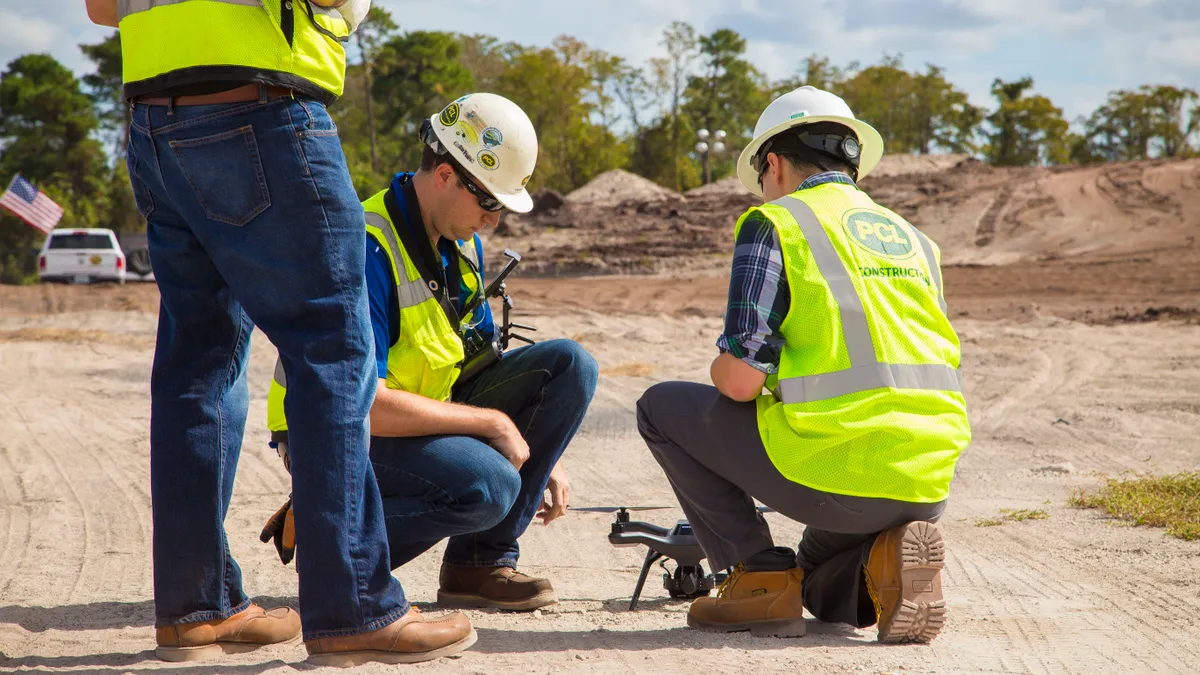Last week, PCL announced its formal partnership with drone technology firm 3DR. The Denver-based construction company, No. 8 on this year's list of top firms, has worked with the tech company for three years to leverage unmanned aircraft systems for site documentation, quality control and progress reporting.
The three-year corporate licensing agreement will make 3DR's software, Site Scan, available for all PCL projects worldwide. Already used on more than 30 PCL projects across North America, Site Scan includes an iPad app for drone flight planning and a web application for turning drone photos into maps and 3D models of construction sites. It also allows project teams to share updates with owners and project stakeholders.
Construction Dive talked with Bill Bennington, PCL's national quality manager, about how the firm has benefited from drone-based technology.
CONSTRUCTION DIVE: What are the top ways you incorporate drones into your construction projects?
BENNINGTON: Utilization of drone technology is similar to having a coach in the press box. It gives a different, more holistic view of a project and allows for more informed decisions on site.
The first benefit that drones bring to a project is through improved jobsite communication. Having current drone data changes the way that we communicate on a project. The old adage that a picture is worth a thousand words has never been more true.
When talking about a scenario during a jobsite meeting, one can easily pull up images of the area being discussed. This adds context to the discussion and often allows the team to resolve issues during the meeting without the typical response of “Let’s walk out and look at this after the meeting.”
Secondly, the analysis tools that are available to our project teams within the web interface are intuitive, efficient and robust. This means that our teams can perform volumetric analysis, overlay design documents with installed work for visual verification, verify grades and much more. These tools are available to all project stakeholders and often bring greater transparency to the work that is being put in place.
Lastly, drones provide a better solution for historical documentation. When questions arise post-construction, having a platform to quickly and efficiently verify what happened and when brings value to all parties involved.
What are some recent projects that have employed unmanned aircraft?
BENNINGTON: Most of our major projects are leveraging drones. PCL averaged 160 drone flights per month in 2018, and we have seen a steady increase in use this year. We’ve been able to streamline existing site documentation workflows and identify potential issues before they come to fruition.
Do you foresee new uses for drones?
BENNINGTON: I see great opportunity to incorporate more artificial intelligence (AI) into the analysis of the drone data. We’re seeing advancements that analyze and detect geometry, slab edges, penetrations and profiles and compare them to the design documents to more quickly identify discrepancies.
Also, object detection with computer vision will be used to find and tag equipment or materials on site. These automations could tie into billing workflows or trigger on-site quality inspections.
How does your partnership with 3DR help solidify your commitment to drone technology?
BENNINGTON: We are working in an era where construction-based technologies are emerging at a very rapid pace. When we determine that a technology is viable and adds value to our projects, it is often challenging to drive adoption and utilization due to the sheer volume of competing technologies. By partnering with 3DR, we are allowing our project teams to focus on consistent implementation and utilization of a single tool. That consistent implementation will add value to our project teams, our trade partners and our clients.















